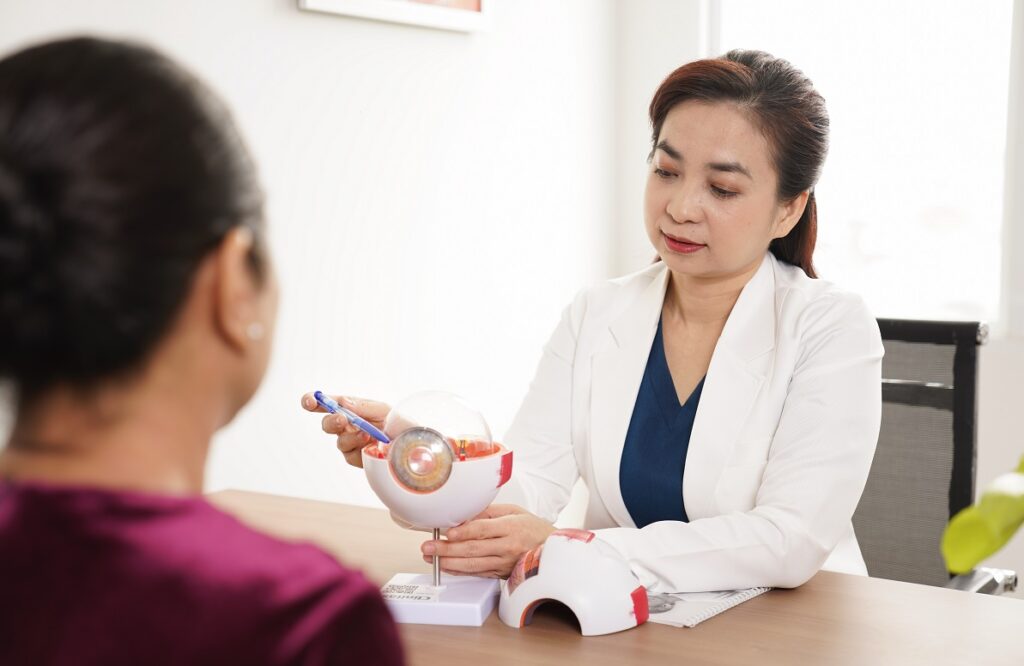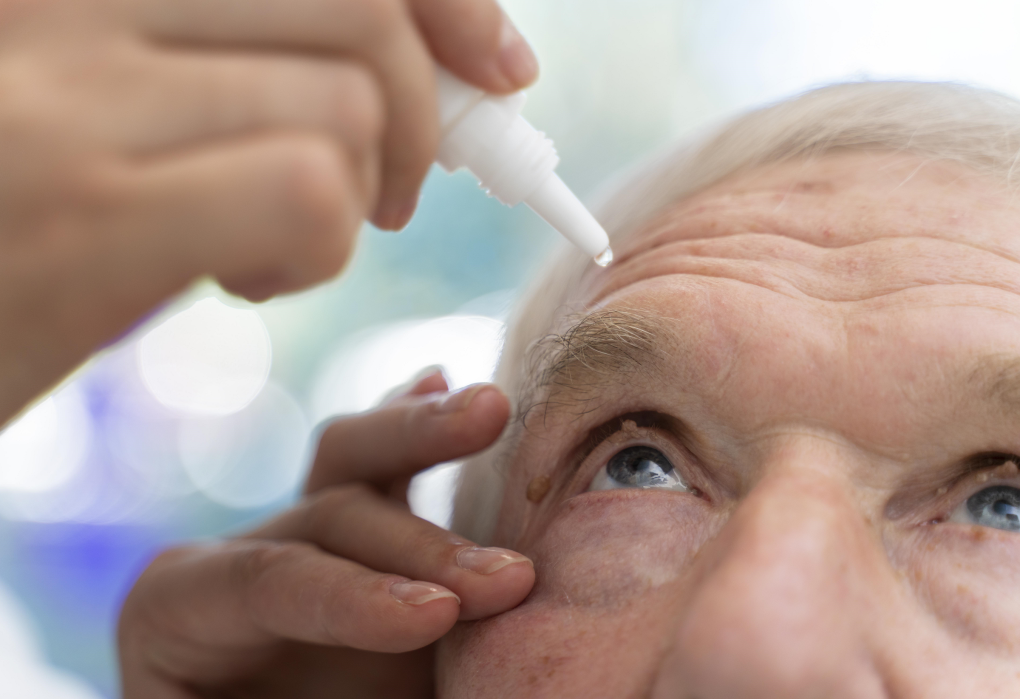
Prima Medical Center Saigon, Eyecare & Aesthetic, Eye Diseases
Guidance of Uveitis
26 August, 2023
Uveitis is an eye disease caused by many causes such as inflammation, trauma, autoimmune disease… The disease can occur at any age, causing many complications, or recurrence and easily leads to blindness.

Dr An Trinh, Prima Saigon, is consulting patients about Uveitis
1. Causes of Uveitis
The uvea is a part of the eye, consisting of three parts: the iris, the ciliary body, and the choroid. Uveitis refers to inflammation of the iris, ciliary body, and choroid. Uveitis is a disease with many complex, sometimes overlapping causes.
The most common causes of uveitis are as follows:
- Inflammation: Inflammation can be caused by bacteria (staphylococci, streptococci, gonorrhea, blue pus bacilli), viruses (herpes), fungi (candida) or parasites (toxoplasma gondii).
- Due to poisoning: from food, chemicals…
- Autoimmune disease (in the body with antibodies against the uvea)
- Due to trauma: penetrating trauma, blunt trauma and then uveitis.
- Secondary from systemic diseases: collagenose, sarcoidose, Behcet’s disease, dermatological disease, blood disease.
In addition, there is uveitis of unknown cause.
2. Classification of uveitis
There are many ways to classify:
- Classification by cause: Uveitis caused by bacteria, viruses, fungi, parasites, allergies, immune …
- Classification according to disease progression: acute uveitis, chronic uveitis, granulomatous chronic uveitis, non-granulomatous uveitis
- Classification according to anatomical location: is the simplest type, commonly used in clinical practice: anterior uveitis (inflammation of the ciliary body), medial uveitis (inflammation of pars plana), uveitis posterior (choroiditis), general uveitis (inflammation of the iris, ciliary body, and choroid at the same time.
3. Symptoms of Uveitis
Patients with anterior uveitis often have conjunctival vascular engorgement (if it is close to the corneal margin, it is called a marginal edema). Vascular engorgement can easily be mistaken for pinkeye, but in fact, with common pinkeye, blood vessels will swell widely.

In addition, there is another sign in anterior uveitis that the patient sees blurred vision, the feeling of seeing something as well as through a layer of fog. Patients with posterior uveitis do not have peripheral edema but often have headache, pain in the eyeball, and blurred vision.
Other symptoms of uveitis include:
- Red eyes, easily confused with conjunctivitis
- Blurry vision, feeling like looking through a fog
Eye pain if accompanied by glaucoma
- Seeing a lot of dark shadows (flying phenomenon)
- Red eyes or red eyes should also suspect uveitis
- Decreased vision, photophobia, lacrimation
4. Diagnosis and treatment of uveitis
In order to accurately diagnose the patient, it is necessary to have a complete examination and tests: complete blood count, blood sugar, chest x-ray, urinalysis, anterior chamber aspiration, vitreous, vitreous biopsy find cause…
Treating uveitis is difficult, because the cause must be treated, but sometimes it is difficult to find the cause

Việc phát hiện và điều trị sớm có thể giảm 95% nguy cơ mù lòa.
Medical treatment: With anterior uveitis, the emergency treatment of atropine drops to dilate the pupils, to prevent adhesions, accounts for 70% of the emergency significance.
As for uveitis in general, the use of medication will depend on the cause of the disease. Some drugs can be selected such as: oral steroid anti-inflammatory drugs, eye drops, injections; drugs to treat infections (mainly antibiotics); antiviral drugs; NSAID pain relievers.
Surgical treatment: For some cases where the disease is worse, or the infection is severe, repeated many times, affecting vision, using ineffective drugs, it is necessary to intervene by surgery. art.
5. Common complications of uveitis
Although it is a non-communicable disease, uveitis can cause many eye complications. With anterior uveitis (iritis or iridocyclitis), the most worrisome condition is pupillary adhesion or occlusion.
This lesion causes both blindness and complications of glaucoma (by obstructing the circulation of aqueous humor from the posterior to anterior chamber of the eyeball). With posterior uveitis, what is ominous is the cloudy vitreous into coarse patches or vitreous pus.
These lesions often cause vitreous organization, complications, and causes retinal detachment and atrophy of the eyeball. In particular, viral posterior uveitis often causes rapid vitreous purulence.
Uveitis, if not detected and treated in time, complications can be extremely serious; it can cause cataracts, glaucoma, even atrophy of the eyeball, the risk of blindness is great.
Our Uveitis Care Team:
- Dr THAO Vo, Chief Medical Officer, Prima Medical Center Saigon
- Dr AN Trinh, Head of General Ophthalmology
- Dr QUOC Nguyen, Senior Consultant
- Dr BINH Tran, Senior Consultant
- Dr TRAN Nguyen, Consultant
If you need an uveitis assessment, please have a visit to Prima Medical Center Saigon:
- Address: 27 Ky Dong St, District 3, HCMC
- Website: https://primahealth.vn/en/
- Business Hours: 07:30 – 17:00 from Monday – Saturday
- HOTLINE: 0919-209-039 or 1900 – 9115
Uveitis is an eye disease caused by many causes such as inflammation, trauma, autoimmune disease… The disease can occur at any age, causing many complications, or recurrence and easily leads to blindness.

Dr An Trinh, Prima Saigon, is consulting patients about Uveitis
1. Causes of Uveitis
The uvea is a part of the eye, consisting of three parts: the iris, the ciliary body, and the choroid. Uveitis refers to inflammation of the iris, ciliary body, and choroid. Uveitis is a disease with many complex, sometimes overlapping causes.
The most common causes of uveitis are as follows:
- Inflammation: Inflammation can be caused by bacteria (staphylococci, streptococci, gonorrhea, blue pus bacilli), viruses (herpes), fungi (candida) or parasites (toxoplasma gondii).
- Due to poisoning: from food, chemicals…
- Autoimmune disease (in the body with antibodies against the uvea)
- Due to trauma: penetrating trauma, blunt trauma and then uveitis.
- Secondary from systemic diseases: collagenose, sarcoidose, Behcet’s disease, dermatological disease, blood disease.
In addition, there is uveitis of unknown cause.
2. Classification of uveitis
There are many ways to classify:
- Classification by cause: Uveitis caused by bacteria, viruses, fungi, parasites, allergies, immune …
- Classification according to disease progression: acute uveitis, chronic uveitis, granulomatous chronic uveitis, non-granulomatous uveitis
- Classification according to anatomical location: is the simplest type, commonly used in clinical practice: anterior uveitis (inflammation of the ciliary body), medial uveitis (inflammation of pars plana), uveitis posterior (choroiditis), general uveitis (inflammation of the iris, ciliary body, and choroid at the same time.
3. Symptoms of Uveitis
Patients with anterior uveitis often have conjunctival vascular engorgement (if it is close to the corneal margin, it is called a marginal edema). Vascular engorgement can easily be mistaken for pinkeye, but in fact, with common pinkeye, blood vessels will swell widely.

In addition, there is another sign in anterior uveitis that the patient sees blurred vision, the feeling of seeing something as well as through a layer of fog. Patients with posterior uveitis do not have peripheral edema but often have headache, pain in the eyeball, and blurred vision.
Other symptoms of uveitis include:
- Red eyes, easily confused with conjunctivitis
- Blurry vision, feeling like looking through a fog
Eye pain if accompanied by glaucoma
- Seeing a lot of dark shadows (flying phenomenon)
- Red eyes or red eyes should also suspect uveitis
- Decreased vision, photophobia, lacrimation
4. Diagnosis and treatment of uveitis
In order to accurately diagnose the patient, it is necessary to have a complete examination and tests: complete blood count, blood sugar, chest x-ray, urinalysis, anterior chamber aspiration, vitreous, vitreous biopsy find cause…
Treating uveitis is difficult, because the cause must be treated, but sometimes it is difficult to find the cause

Việc phát hiện và điều trị sớm có thể giảm 95% nguy cơ mù lòa.
Medical treatment: With anterior uveitis, the emergency treatment of atropine drops to dilate the pupils, to prevent adhesions, accounts for 70% of the emergency significance.
As for uveitis in general, the use of medication will depend on the cause of the disease. Some drugs can be selected such as: oral steroid anti-inflammatory drugs, eye drops, injections; drugs to treat infections (mainly antibiotics); antiviral drugs; NSAID pain relievers.
Surgical treatment: For some cases where the disease is worse, or the infection is severe, repeated many times, affecting vision, using ineffective drugs, it is necessary to intervene by surgery. art.
5. Common complications of uveitis
Although it is a non-communicable disease, uveitis can cause many eye complications. With anterior uveitis (iritis or iridocyclitis), the most worrisome condition is pupillary adhesion or occlusion.
This lesion causes both blindness and complications of glaucoma (by obstructing the circulation of aqueous humor from the posterior to anterior chamber of the eyeball). With posterior uveitis, what is ominous is the cloudy vitreous into coarse patches or vitreous pus.
These lesions often cause vitreous organization, complications, and causes retinal detachment and atrophy of the eyeball. In particular, viral posterior uveitis often causes rapid vitreous purulence.
Uveitis, if not detected and treated in time, complications can be extremely serious; it can cause cataracts, glaucoma, even atrophy of the eyeball, the risk of blindness is great.
Our Uveitis Care Team:
- Dr THAO Vo, Chief Medical Officer, Prima Medical Center Saigon
- Dr AN Trinh, Head of General Ophthalmology
- Dr QUOC Nguyen, Senior Consultant
- Dr BINH Tran, Senior Consultant
- Dr TRAN Nguyen, Consultant
If you need an uveitis assessment, please have a visit to Prima Medical Center Saigon:
- Address: 27 Ky Dong St, District 3, HCMC
- Website: https://primahealth.vn/en/
- Business Hours: 07:30 – 17:00 from Monday – Saturday
- HOTLINE: 0919-209-039 or 1900 – 9115



